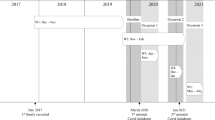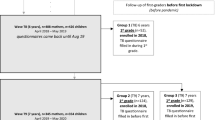Abstract
The study objective was to examine the mental health of children during a time period that included the COVID-19 Lockdown. The sample included a cross-section of children aged 2 to 17 years (2019; n = 4, 194; 2020; n = 5,172), from the National Health Interview Survey. In multivariate models, survey years 2020 and 2019 were compared for significant changes in anxiety, depression, and social behaviors in children after adjustment for sociodemographic variables. Bivariate analysis also examined sociodemographic characteristics, health care utilization by anxiety, depression, and social behaviors, and examined differences in anxiety and depression from 2019 to 2020. In multivariate models, there was an increased risk of anxiety ((AOR = 1.3(1.0, 1.6)), depression ((AOR = 1.2 (1.0, 1.4)) and difficult social behaviors (AOR = 1.2 (1.0, 1.4) in children from 2019 to 2020. Girls were at increased risk compared to boys for anxiety and depression ((anxiety; AOR = 1.4 (1.2, 1.8), depression; AOR = 1.2 (1.0, 1.3)), however, girls were at decreased risk compared to boys for uncontrolled social behaviors (AOR = 0.51 (0.43, 0.61)). White children were at increased risk for anxiety and depression compared to all other race and ethnic groups. High rates of anxiety, depression and difficult social behaviors that preexisted the Covid-19 Lock Down, continued or increased during the Lockdown. Effective public health interventions could prevent further declines in mental health, and a potential trajectory into adulthood of poor physical and mental health.
Similar content being viewed by others
Explore related subjects
Discover the latest articles and news from researchers in related subjects, suggested using machine learning.Data Availability
No datasets were generated or analysed during the current study.
References
Chilamakuri R, Agarwal S (2021) COVID-19: characteristics and therapeutics. Cells 10(2):206. https://doi.org/10.3390/cells10020206
Janik E, Niemcewicz M, Podogrocki M et al (2021) The emerging concern and interest SARS-CoV-2 variants. Pathogens 10(6):633. https://doi.org/10.3390/pathogens10060633
Berger LM, Ferrari G, Leturcq M et al (2021) COVID-19 lockdowns and demographically-relevant Google trends: a cross-national analysis. Ortega JA. ed PLOS ONE 16(3):e0248072. https://doi.org/10.1371/journal.pone.0248072
Tandon PS, Zhou C, Johnson AM et al (2021) Association of children’s physical activity and screen time with mental health during the COVID-19 pandemic. JAMA Netw Open 4(10):e2127892. https://doi.org/10.1001/jamanetworkopen.2021.27892
Raimondi S, Cammarata G, Testa G et al (2022) The impact of sport activity shut down during the COVID-19 pandemic on children, adolescents, and young adults: was it worthwhile? Int J Environ Res Public Health 19(13):7908. https://doi.org/10.3390/ijerph19137908
Burgos RM, Badowski ME, Drwiega E et al (2021) The race to a COVID-19 vaccine: opportunities and challenges in development and distribution. Drugs Context 10:1–10. https://doi.org/10.7573/dic.2020-12-2
KFF COVID-19 Vaccine Monitor Dashboard, Published KFF (2021) February 26, https://www.kff.org/coronavirus-covid-19/dashboard/kff-covid-19-vaccine-monitor-dashboard/
Hause AM (2021) COVID-19 vaccine safety in adolescents aged 12–17 years — United States, December 14, 2020–July 16, 2021. MMWR 70. https://doi.org/10.15585/mmwr.mm7031e1
Lebrun-Harris LA, Ghandour RM, Kogan MD et al (2022) Five-Year Trends in US Children’s Health and Well-being, 2016–2020. JAMA Pediatr Published Online March 14. https://doi.org/10.1001/jamapediatrics.2022.0056
NHIS – 2020 NHIS. www.cdc.gov. Published February 4 (2021) https://www.cdc.gov/nchs/nhis/2020nhis.htm
NHIS - About the National Health Interview Survey (2019) https://www.cdc.gov/nchs/nhis/about_nhis.htm
Liu X, Liu C, Liu G et al (2020) COVID-19: progress in diagnostics, therapy and vaccination. Theranostics 10(17):7821–7835. https://doi.org/10.7150/thno.47987
IPUMS NHIS nhis.ipums.org. https://nhis.ipums.org/nhis/userNotes_weights.shtml
BSG Working Paper Series Variation in US States’ COVID-19 policy responses. //efaidnbmnnnibpcajpcglclefindmkaj/https://www.bsg.ox.ac.uk/sites/default/files/2021-05/BSG-WP-2020-034-v3.pdf
McCarthy JF, Blow FC, Ignacio RV et al (2012) Suicide among patients in the veteran’s affairs health system: rural–urban differences in rates, risks, and methods. Am J Public Health 102(S1):S111–S117. https://doi.org/10.2105/ajph.2011.300463
Weissman JD, Russell D (2016) Relationships between living arrangements and health status among older adults in the United States, 2009–2014: Findings from the national health interview survey. J Applied Gerontology. June 26, 37(1):7–25, 201. https://doi.org/10.1177/0733464816655439
Weissman J, Minen MT, Tietjen G (2020) Response to Dr. Woldeamanuel. Pain Med 21(4):872–873. https://doi.org/10.1093/pm/pnz288
Sun GW, Shook TL, Kay GL (1996) Inappropriate use of bivariable analysis to screen risk factors for use in multivariable analysis. J Clin Epidemiol 49(8):907–916. https://doi.org/10.1016/0895-4356(96)00025-x
Harrell FE (2001) Regression modeling strategies. Springer New York. https://doi.org/10.1007/978-1-4757-3462-1
Villanueva K, Badland H, Kvalsvig A, O’Connor M, Christian H, Woolcock G, Giles-Corti B, Goldfeld S (2016) Jan-Feb;16(1):10 – 9 Can the Neighborhood Built Environment Make a Difference in Children’s Development? Building the Research Agenda to Create Evidence for Place-Based Children’s Policy. Acad Pediatr. doi: 10.1016/j.acap.2015.09.006. Epub 2015 Nov 25. PMID: 26432681
Essau CA, Lewinsohn PM, Lim JX et al (2018) Incidence, recurrence and comorbidity of anxiety disorders in four major developmental stages. J Affect Disord 228:248–253. https://doi.org/10.1016/j.jad.2017.12.014
Howie EK, McVeigh JA, Smith AJ et al (2020) Physical activity trajectories from childhood to late adolescence and their implications for health in young adulthood. Prev Med 139:106224. https://doi.org/10.1016/j.ypmed.2020.106224
Karyotaki E, Smit Y, Holdt Henningsen K et al (2016) Combining pharmacotherapy and psychotherapy or monotherapy for major depression? A meta-analysis on the long-term effects. J Affect Disord 194:144–152. https://doi.org/10.1016/j.jad.2016.01.036
Weissman J, Pratt L, Miller E, Parker J (2015) Key Findings.; https://www.cdc.gov/nchs/data/databriefs/db203.pdf
Kravdal Ø, Grundy E (2019) Children’s age at parental divorce and depression in early and mid-adulthood. Pop Stud 73(1):37–56. https://doi.org/10.1080/00324728.2018.1549747
Ritakallio M, Luukkaala T, Marttunen M et al (2010) Comorbidity between depression and antisocial behaviour in middle adolescence: the role of perceived social support. Nord J Psychiatry 64(3):164–171. https://doi.org/10.3109/08039480903264911
Acknowledgements
None.
Funding
No funding was required for this manuscript.
Author information
Authors and Affiliations
Contributions
All of the authors contributed to the conceptualization, analysis, design and writing of this study.
Corresponding author
Ethics declarations
Ethics Approval and Consent to Participate
No IRB or additional ethical review was required because the data was publicly available from the CDC’s National center for Health Statistics (NcHS). Respondents were consented and made anonymous by the NcHS. The research did not involve the use of animals. No humans were interviewed by us for this study. Individuals were interviewed by the Centers for Disease Control and Prevention (CDC) and their identification was made completely anonymous. Information was gathered only after consent. The CDC conducts research under the highest ethical standards and the data was made publicly available.
Competing Interests
The authors declare no competing interests.
Additional information
Publisher’s Note
Springer Nature remains neutral with regard to jurisdictional claims in published maps and institutional affiliations.
Rights and permissions
Springer Nature or its licensor (e.g. a society or other partner) holds exclusive rights to this article under a publishing agreement with the author(s) or other rightsholder(s); author self-archiving of the accepted manuscript version of this article is solely governed by the terms of such publishing agreement and applicable law.
About this article
Cite this article
Weissman, J.D., Kramsky, J.B., Pinder, N. et al. An Examination of Mental Health Rates in Children During the First Year of the COVID-19 Pandemic: Findings from the National Health Interview Survey 2019–2020. Child Psychiatry Hum Dev (2024). https://doi.org/10.1007/s10578-024-01759-2
Accepted:
Published:
DOI: https://doi.org/10.1007/s10578-024-01759-2




